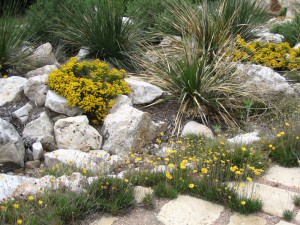When it comes to low maintenance, damianita reigns! Plant this drought-mocking native and you will have a bright display of color, texture AND butterflies!
Nothing shouts spring more than a plant with bright yellow blossoms and evergreen foliage. Bonus if the plant is deer-resistant and appealing to butterflies.
Meet Damianita (Chrysactinia mexicana), a cheerful, yellow-blossomed plant that naturally occurs on rocky outcrops in the Edwards Plateau and Trans-Pecos regions of Texas. It tolerates poor soils, extreme heat and full sun. Damianita is a tiny shrub that usually has a maximum size of one foot tall and two feet wide. The aromatic foliage is not a favorite of deer and the blossoms attract butterflies in profusion. This plant can handle anything, well, almost anything. It must have full sun and well-drained soil. Damianita will die if it receives too much water, or it won’t bloom and grow spindly if it doesn’t receive adequate sunlight.

For best results, plant damianita and other perennials in the fall or winter when most plants are dormant. Although plants may not appear to be growing at this time, winter is when plant roots are doing a lot of underground work. Planting at this time ensures your new plant will develop a healthy root system. A plant without healthy roots will have a hard time surviving San Antonio’s brutal summers. Think of it as building a home, you want your home to have a strong foundation so that it can withstand the harsh elements. Roots are the foundation of a plant.
When creating a garden bed with this plant, be sure to group it with other plants that have similar sun and water requirements. For example, you would not want to plant it under a magnolia tree because the shade of the magnolia will not give damianita its full sun requirement. Also, magnolias require a lot of water while damianita requires no supplemental water other than what it takes to get it established.
Look to nature for design ideas

When I hike in the hill country and in west Texas, I see damianita growing amongst other drought-tolerant perennials such as fragrant mimosa, agarita, sotol, tall grama, bear grass, seep muhly, purple prairie clover, black dalea, fluttermills, Blackfoot daisy, little bluestem, yucca, agave, sideoats grama, gayfeather and antelope horns. You do not have to use all of these plants in a bed, space may not allow for all of them and some may not be available at nurseries. Choose a few, but know that any and all of these plants are super tough performers and require very little maintenance and resources. Try using a damianita combination in your “inferno strip” (the thin strip between the sidewalk and the street) that usually has grass, but is notoriously hard to water. Try to avoid planting agave and yucca close walkways as it could be a safety hazard.

Benefit to Wildlife
A variety of wildlife species will benefit from a diverse landscape. When planting with wildlife in mind, remember it’s important to have something blooming from early spring until fall. For instance, the early, sweet-smelling flowers of agarita will provide nectar and pollen for insects, the fruits that form later will attract songbirds and the evergreen foliage will provide shelter for wildlife. Once the flowers of agarita are gone, the damianita and other plants’ blossoms will provide nectar and pollen. In the fall, gayfeather provides nectar and pollen. Just like humans need a steady supply of food and water, pollinators need a steady supply of nectar and pollen. Remember: avoid pesticides if you want healthy insects and birds.
When it comes to low maintenance, damianita reigns! Plant it accordingly and you’ll have a bright display of color, texture AND butterflies!


